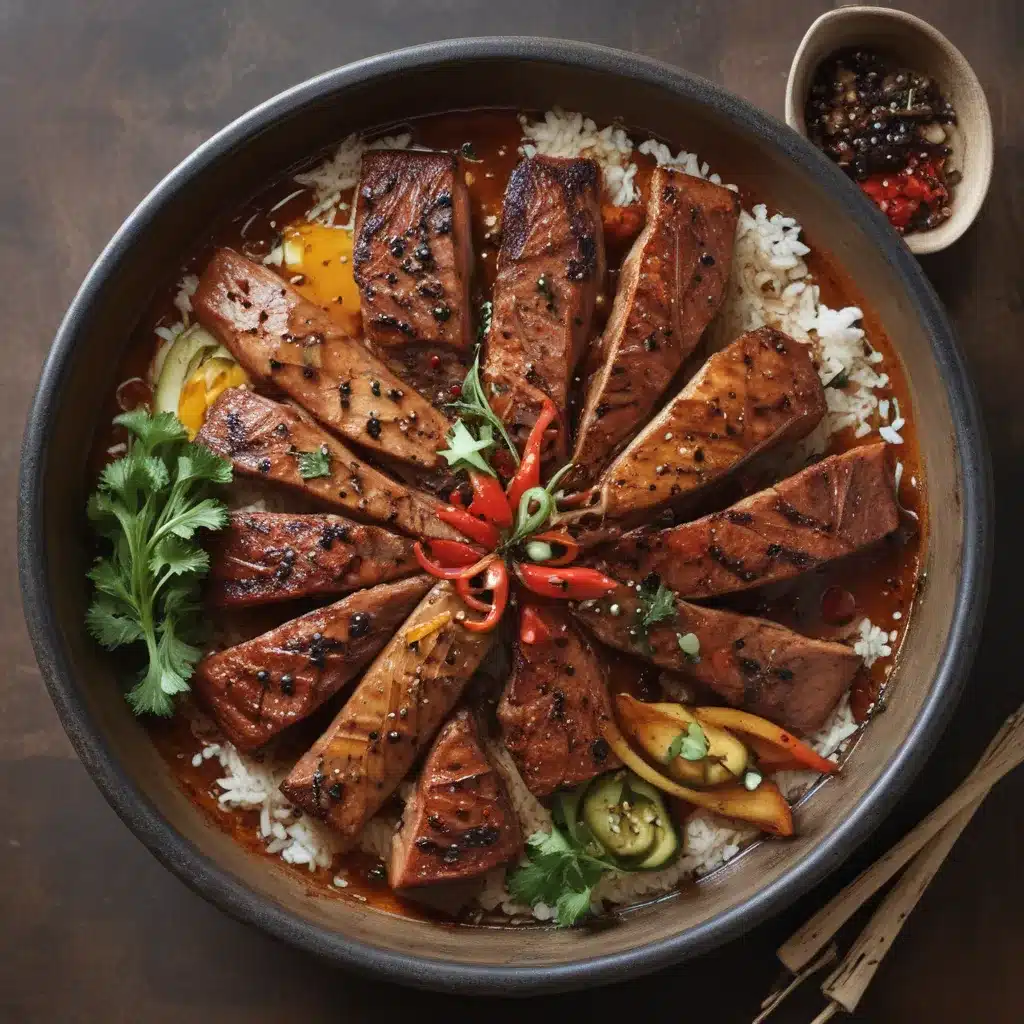
Unlocking the Flavors of Korea
As I step into the bustling kitchen of Korean Garden, the aromas of sizzling meats and fragrant spices immediately transport me to the vibrant streets of Seoul. It’s here, amidst the sizzle and steam, that I’m about to embark on a flavor journey like no other – exploring the art of Korean-inspired rubs and marinades.
You see, Korean cuisine is not just about the end result; it’s a symphony of preparation techniques, carefully curated blends, and a deep respect for the ingredients. And today, I’m here to let you in on the secrets that will have your taste buds dancing with delight.
Unlocking the Secrets of Korean Rubs
Let’s start with the foundation of any great Korean dish – the rub. These dry seasoning blends are the building blocks that infuse your proteins with a depth of flavor that goes beyond the surface.
One of the hallmarks of a Korean rub is the use of gochugaru, a Korean red chili pepper that adds a smoky, slightly sweet heat. But the true magic lies in the way these rubs are constructed, blending aromatic spices, earthy seasonings, and a touch of sweetness to create a perfect balance.
Take, for example, the signature rub used on the bulgogi at Korean Garden. The chefs here meticulously combine brown sugar, garlic, onion, soy sauce, and that all-important gochugaru to create a rub that penetrates the beef and transforms it into a mouthwatering masterpiece.
But the art of the rub doesn’t stop there. I’ve had the privilege of learning from the master chefs at Korean Garden, and they’ve shared with me the secrets to crafting the perfect rub for everything from pork belly to chicken thighs.
One of my personal favorites is the rub they use on their Korean-style short ribs. It’s a harmonious blend of brown sugar, ginger, sesame seeds, and a touch of ground black pepper that caramelizes on the meat, creating a delectable crust that seals in the juices.
Marinades: The Liquid Alchemy of Korean Cuisine
While rubs are the foundation, marinades are the liquid alchemy that take Korean dishes to new heights. These flavor-packed solutions not only tenderize the proteins but also infuse them with a depth of taste that will have your guests questioning whether you’ve been secretly studying under a Korean grandmaster.
At Korean Garden, they’ve perfected the art of the marinade, utilizing a unique blend of soy sauce, rice vinegar, brown sugar, and an array of aromatic ingredients to create a symphony of flavors.
Take, for instance, their famous bulgogi marinade. It’s a captivating concoction that starts with a base of soy sauce, brown sugar, and rice vinegar, but it’s the addition of pear puree, garlic, and onion that truly sets it apart. The natural sweetness of the pear balances the savory soy, while the garlic and onion lend a fragrant backdrop that permeates the beef, transforming it into a dish that’s worthy of a Seoul street food stall.
But the marvels of Korean marinades don’t end there. I’ve had the pleasure of sampling their gochujang-based marinade, which they use for their spicy pork dishes. This fiery condiment, made from fermented chili peppers, adds a bold kick that’s tempered by the sweetness of brown sugar and the tang of rice vinegar.
Unlocking the Versatility of Korean Rubs and Marinades
The beauty of Korean rubs and marinades lies in their versatility. These flavor profiles aren’t limited to just Korean dishes; they can be used to elevate a wide range of proteins and even vegetables, opening up a world of culinary possibilities.
Imagine a juicy pork chop, rubbed with the signature bulgogi blend and then grilled to perfection. Or how about a plate of crispy, Korean-style fried chicken, coated in a marinade that combines the smoky heat of gochujang with the sweetness of honey?
But the experimentation doesn’t stop there. I’ve even tried using the gochujang marinade on roasted sweet potatoes, resulting in a side dish that’s both savory and subtly sweet, with a hint of that irresistible Korean kick.
Fostering a Culinary Adventure at Home
As I reflect on my time spent in the kitchen with the talented chefs at Korean Garden, I’m struck by the realization that the art of Korean rubs and marinades is not just about the end result – it’s about the journey.
It’s about embracing the unexpected, experimenting with flavors, and discovering new ways to invigorate your culinary repertoire. And the best part? You don’t need to be a seasoned Korean cuisine expert to get in on the action.
I encourage you to venture into your own kitchen, armed with the secrets I’ve shared today, and let your culinary creativity run wild. Start with a classic bulgogi marinade and see how it transforms a simple flank steak. Or dive headfirst into the world of gochujang and explore its versatility across your favorite dishes.
The possibilities are endless, and the rewards are oh-so-delicious. So, what are you waiting for? It’s time to spice it up and unlock the flavors of Korea, right in your own home.
And if you’re ever in the Boston area, be sure to visit Korean Garden Boston to experience the true essence of Korean cuisine. Their master chefs are waiting to guide you on a culinary adventure that will leave you craving more.
